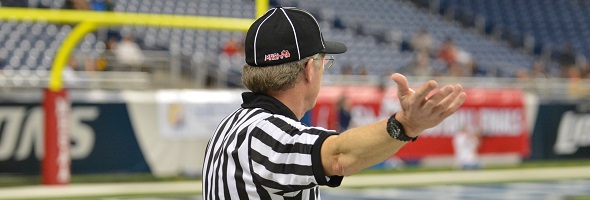
Be the Referee: Pass Interference
September 9, 2014
This week, MHSAA assistant director Mark Uyl explains one of the toughest calls to make on the football field.
"Be the Referee" is designed to help educate people on the rules of different sports, to help them better understand the art of officiating and to recruit officials. The segment can be heard on Mondays, Wednesdays and Fridays during the school year on The Drive With Jack Ebling on WVFN-AM, East Lansing.
Below is this week's segment - Pass Interference - Listen
Today we’re going to talk about one of the most difficult calls for any football official – pass interference. It’s important to know that whenever a forward pass is thrown beyond the line of scrimmage that both players – the offensive receiver as well as the defender – each have an equal right to make a play on the football.
Now, not all contact will automatically result in a pass interference foul. The official must judge if that early contact before the ball arrives has placed one of the two players at a distinct disadvantage. When that contact does create the disadvantage, you have a foul for pass interference. When the contact is minimal and is simply incidental, no foul has occurred.
Past editions
Aug. 25 - Targeting - Listen
Sept. 4 - Concussions - Listen

Be the Referee: Toe the Line on PKs
October 15, 2020
This week, MHSAA officials coordinator Sam Davis explains a change in soccer affecting goalkeeper movement during penalty kicks.
Be The Referee is a series of short messages designed to help educate people on the rules of different sports, to help them better understand the art of officiating, and to recruit officials.
Below is this week's segment - Toe the Line on Penalty Kicks - Listen
Here’s a high school soccer rules change for the upcoming season. Rules for the placement and movement of the goalkeeper on a penalty kick have been rewritten to make it more clear what a keeper can or cannot do.
As in previous years, goalkeepers can move laterally along the goal line prior to the taking of the penalty kick. But new this year, goalkeepers need only have one foot on (or in-line) with the goal line at the time of the kick.
This allows keepers to lunge before the ball is kicked, as long as one foot stays on the line. Previously, the goalie needed to keep both feet on the goal line or in line.
Past editions
10/8: Disconcerting Acts - Listen
10/1: Ball Hits Soccer Referee - Listen
9/24: Clocking the Ball from the Shotgun - Listen

